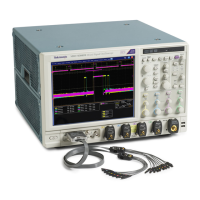Commands Listed in Alphabetical Order
Group
Search and Mark
Syntax
SEARCH:SEARCH<x>:TRIGger: A:GLItch:POLarity:REF<x>
{EITher|NEGAtive|POSITIVe }
SEARCH:SEARCH<x>:TRIGger: A:GLItch:POLarity:REF<x>?
Arguments
EITher specifi es positive or negative polarity.
NEGAtive specifies a negative polarity.
POSITIVe specifies a positive glitch polarity.
Examples
SEARCH:SEARCH1:TRIGGER:A: GLITCH:POLARITY:REF2 NEGA TIVE
specifies that the Reference 2 waveform glitch polarity must be negative for
search 1.
SEARCH:SEARCH1:TRIGGER:A: GLITCH:POLARITY:REF1? might return
:SEARCH:SEARCH1:TRIGGER:A :GLITCH:POLARITY:REF1 POS ITIVE,
indicating that the Reference 1 waveform glitch polarity for search 1 is positive.
SEARCH:SEARCH<x>:TRIGger:A:GLItch:TRIGIF
This command sets or queries the accept or reject state for a glitch trigger search
to determine where to place a mark. <x> is the search number.
Group
Search and Mark
Syntax
SEARCH:SEARCH<x>:TRIGger: A:GLItch:TRIGIF {ACCept|REJect}
SEARCH:SEARCH<x>:TRIGger: A:GLItch:TRIGIF?
Arguments
ACCept specifies that a glitch occurs.
REJect specifies that a glitch does not occur.
Examples
SEARCH:SEARCH1:TRIGGER:A: GLITCH:TRIGIF ACCEPT specifies to place
a mark if the A trigger glitch occurs.
SEARCH:SEARCH1:TRIGGER:A: GLITCH:TRIGIF? might return
:SEARCH:SEARCH1:TRIGGER:A :GLITCH:TRIGIF ACCEPT, indicating that a
mark will be placed if a glitch occurs.
2-446 DPO7000, DPO70000/B and DSA7000/B Series Programmer Manual
